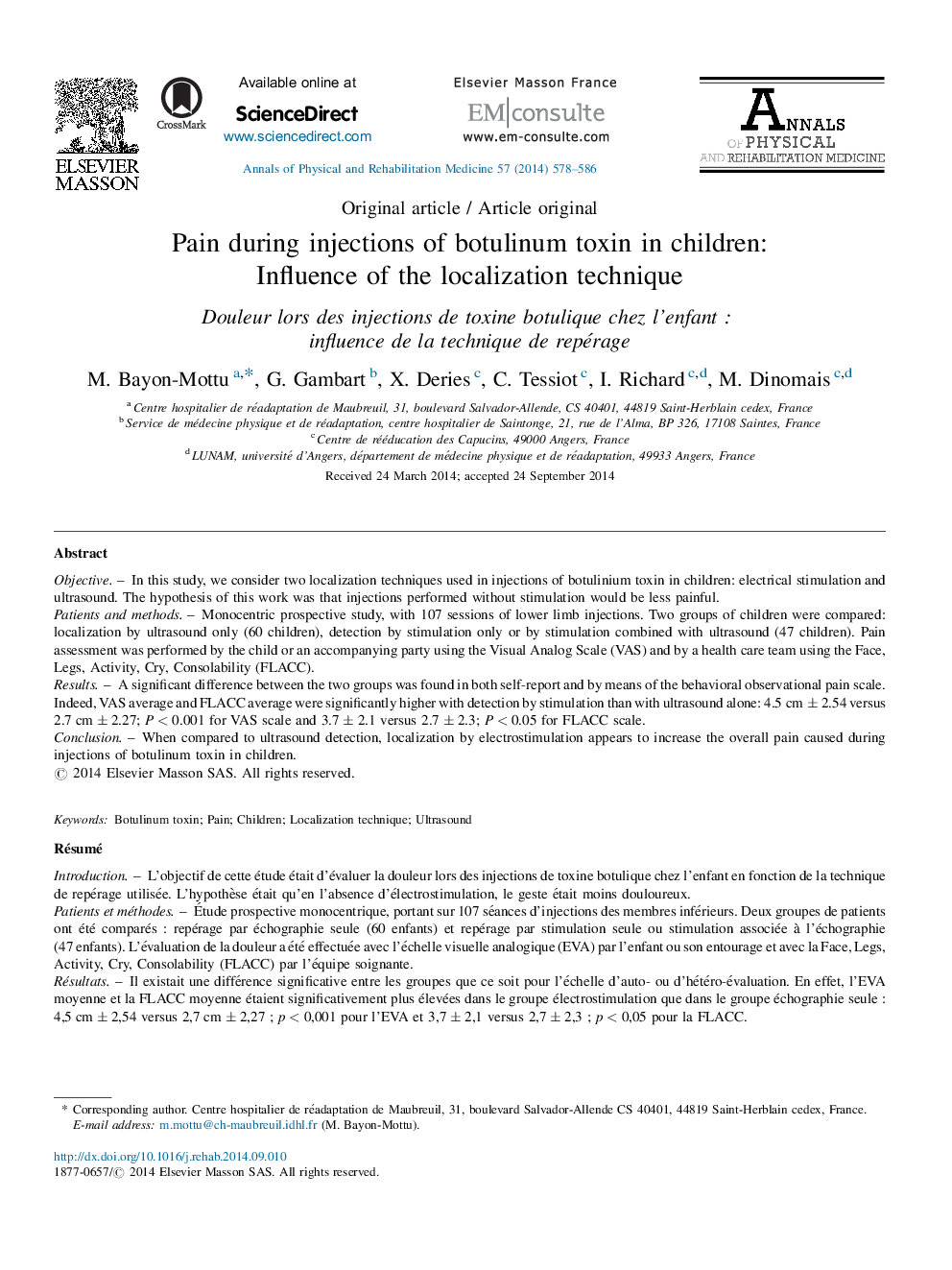| کد مقاله | کد نشریه | سال انتشار | مقاله انگلیسی | نسخه تمام متن |
|---|---|---|---|---|
| 4040509 | 1603304 | 2014 | 9 صفحه PDF | دانلود رایگان |
ObjectiveIn this study, we consider two localization techniques used in injections of botulinium toxin in children: electrical stimulation and ultrasound. The hypothesis of this work was that injections performed without stimulation would be less painful.Patients and methodsMonocentric prospective study, with 107 sessions of lower limb injections. Two groups of children were compared: localization by ultrasound only (60 children), detection by stimulation only or by stimulation combined with ultrasound (47 children). Pain assessment was performed by the child or an accompanying party using the Visual Analog Scale (VAS) and by a health care team using the Face, Legs, Activity, Cry, Consolability (FLACC).ResultsA significant difference between the two groups was found in both self-report and by means of the behavioral observational pain scale. Indeed, VAS average and FLACC average were significantly higher with detection by stimulation than with ultrasound alone: 4.5 cm ± 2.54 versus 2.7 cm ± 2.27; P < 0.001 for VAS scale and 3.7 ± 2.1 versus 2.7 ± 2.3; P < 0.05 for FLACC scale.ConclusionWhen compared to ultrasound detection, localization by electrostimulation appears to increase the overall pain caused during injections of botulinum toxin in children.
RésuméIntroductionL’objectif de cette étude était d’évaluer la douleur lors des injections de toxine botulique chez l’enfant en fonction de la technique de repérage utilisée. L’hypothèse était qu’en l’absence d’électrostimulation, le geste était moins douloureux.Patients et méthodesÉtude prospective monocentrique, portant sur 107 séances d’injections des membres inférieurs. Deux groupes de patients ont été comparés : repérage par échographie seule (60 enfants) et repérage par stimulation seule ou stimulation associée à l’échographie (47 enfants). L’évaluation de la douleur a été effectuée avec l’échelle visuelle analogique (EVA) par l’enfant ou son entourage et avec la Face, Legs, Activity, Cry, Consolability (FLACC) par l’équipe soignante.RésultatsIl existait une différence significative entre les groupes que ce soit pour l’échelle d’auto- ou d’hétéro-évaluation. En effet, l’EVA moyenne et la FLACC moyenne étaient significativement plus élevées dans le groupe électrostimulation que dans le groupe échographie seule : 4,5 cm ± 2,54 versus 2,7 cm ± 2,27 ; p < 0,001 pour l’EVA et 3,7 ± 2,1 versus 2,7 ± 2,3 ; p < 0,05 pour la FLACC.ConclusionLe repérage par électrostimulation semble augmenter la douleur globale du geste par rapport à l’utilisation de l’échographie.
Journal: Annals of Physical and Rehabilitation Medicine - Volume 57, Issues 9–10, December 2014, Pages 578–586
